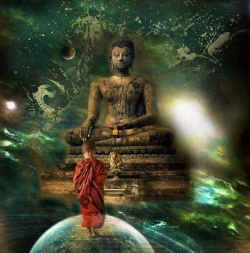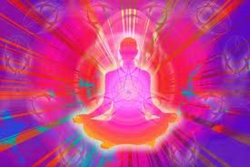Tathagatagarbha: the womb of Buddhahood
This is one of those concepts in Buddhism that really, really confused me for a long time but thought I’d expand on it a bit. After finishing some readings on Yogacara Buddhism, I turned my attention back to an old classic on Avatamsaka, or Huayan Buddhism, a rival school originally from China (where Yogacara was from India). The “term” rival here, means just that both schools debated heavily for a time in China, and though both later died out, they left a philosophical legacy for modern Buddhist schools to carry on.1
The book I’ve been re-reading2 is Francis Cook’s classic, Hua-yen: the Jewel Net of Indra, and so far I’ve made it to chapter 3, where it explores some key concepts of Huayan Buddhism. It spends a lot of time talking about the notion of sunyata or “emptiness”, which was first coined in the Madhyamika school of India.3 Emptiness is a big concept in Mahayana Buddhism and explains the notion that all things are “empty” of an independent and permanent identity. Here today, something else tomorrow. Also, nothing just appears on its own magically, but through external causes and conditions, hence the lack of an independent existence.
Then the book shifts directions and talks about the Tathāgatagarbha, the “womb of Buddhahood” in Sanskrit. While this term is popular in places like Shingon Buddhism and such,4 I’ve just never understood it. Frankly, the term “womb” just sounded gross to me. :-p
But Francis Cook explains it this way:
…the basic idea is that of some element which is intrinsic to beings which will ensure their ultimate attainment of the goal. The doctrine of tathāgatagarbha is a recognition the fact that the goal of Buddhahood is not to be sought exterior to beings themselves, in some other time and place, but is a potential always existing within them. Thus sarvasattvās tathāgatagarbhāḥ, translated as “all beings are the wombs of Buddhahood,” means beings are the containers or matrix in which Buddhahood can grow. (pg. 45)
So, here the term “womb” makes sense in the analogy of something growing inside to reach full potential. Next Cook relates this to the Yogacara concept of Store Consciousness, mentioned recently:
When the store-consciousness is purified through the “transformation of the basis” (āśraya-parāvṛtti) is becomes the source of Buddhahood, for it contains, from beginning-less time, not only the seeds of defilement and ignorance, but the seeds of purification and wisdom as well. (pg. 47)
So, the “womb” clearly relates to the Yogacara store-consciousness, that most fundamental part of the mind that stores all experiences (seeds) and shapes the thoughts and actions of the future. As mentioned in the previous post on the subject, life is a constant cycle of accumulated experiences, or “seeds” driving the action, and the actions “perfuming” the seeds a certain way.
So, making the intentional act of living a wholesome life, cultivating wisdom and such, lead toward purification until the potential for Buddhahood begins to grow within the Womb of Buddhahood.
Cook finally summarizes this another way for practical purposes:
if the term śūnyatā (emptiness) is used, the emphasis is on the epistemological and perhaps ontological; if tathāgatagarbha (womb of the buddha) is used, the stress is on the soteriological and “practical”. The doctrine of tathāgatagarbha stresses the innate potential for Buddhahood in beings but this Buddhahood itself is nothing more than the perfection of the ability to experience reality in the emptiness mode. (pg. 47)
This is by far the best part of this whole chapter. These are two concepts that I’ve heard, but never really understood. What Cook is saying is that they are two sides of the same coin. The term “emptiness” (sunyata) refers to the origin of things, the state of things now. Everything is interdependent, impermanent, etc. But when it comes to the practical side, concerned with the liberation of all beings, when the term “womb of the buddha” is used to explain how through change and purification one can cultivate the seeds of Buddhahood.
Mahayana Buddhism in other words is a way to explain reality as it is, but also a way to awaken the ability to see reality as it is through cultivation and purification.
Good stuff. :)
Namo Shakyamuni Buddha
Update: Prof. Charles Muller left a helpful comment in the post clarifying the relationship of the Tathagatagarbha and the Store Consciousness below, which I recommend reading for more information. :)
1 In Japan, both did survive as the Hossō (法相, Yogacara) and Kegon (華厳 Huayan, Avatamsaka). Both still exist, mainly based around Nara, Japan where Buddhism was originally established, but their influence is diminished somewhat compared to more popular schools. Nevertheless a lively scholarly tradition continues, and they still influence the thought of the more popular schools to this day.
2 Read this book 5 years ago when I first took Buddhism seriously, but don’t recall too much. I don’t think my understanding at the time was mature to grasp certain concepts. Still isn’t. ;)
3 Which survived in Japan as the sanron (三論) school, but I am told by a reliable source that by the 13th century they had reached their logical end and died out.
4 Although not mentioned, I suspect these doctrines also influence Jodo Shinshu Buddhism quite a bit too.



